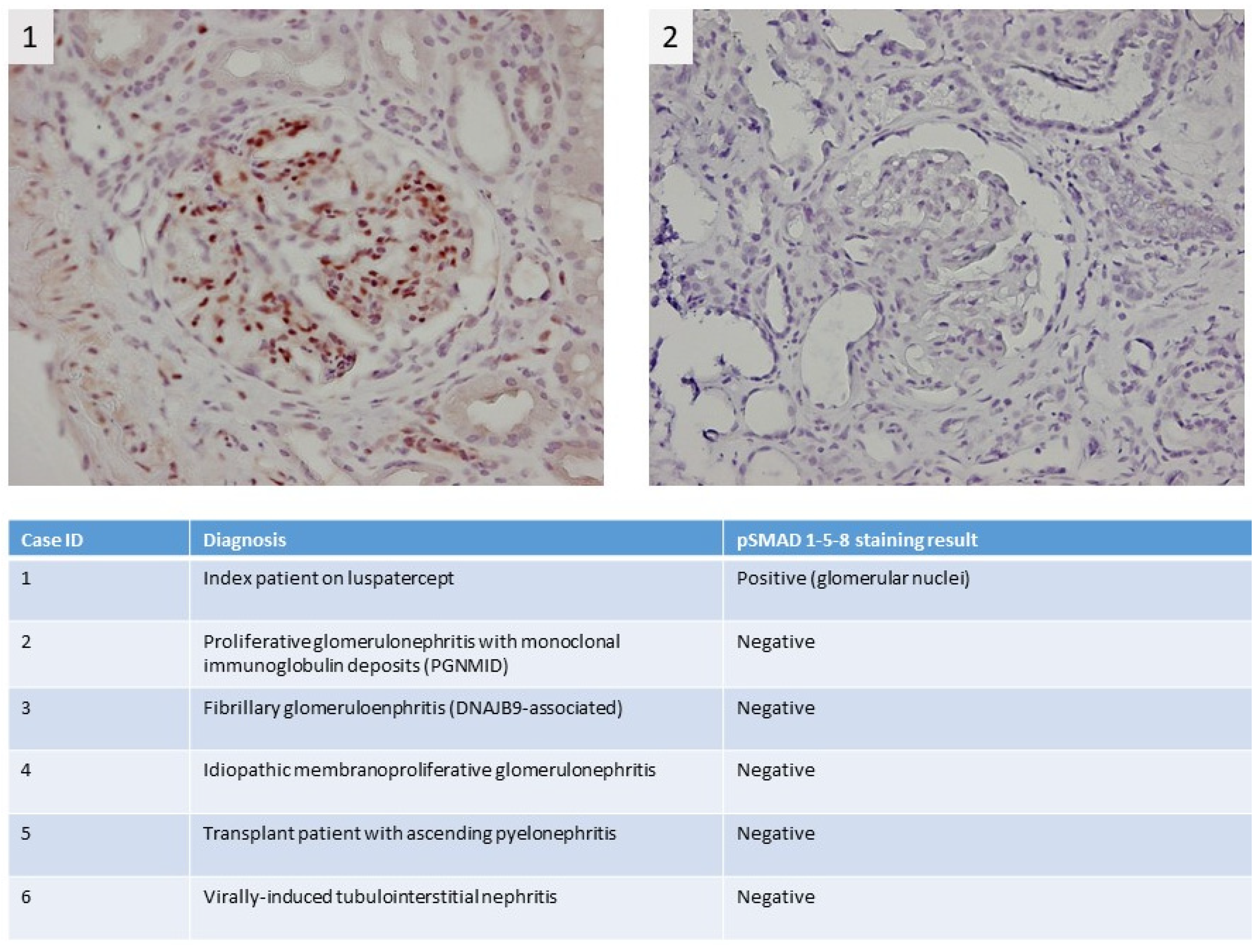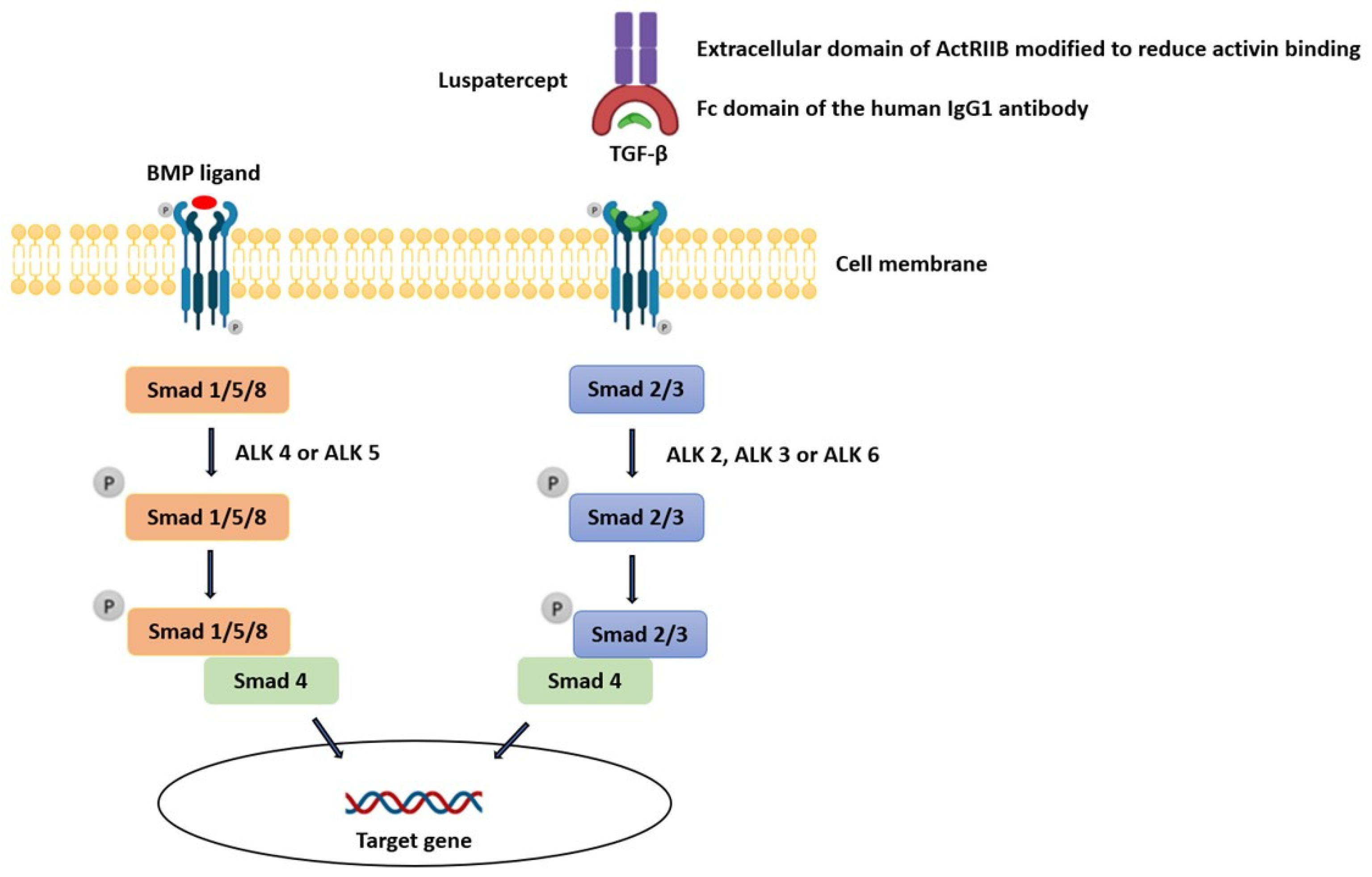Immune Complex Glomerulonephritis in a Patient with Myelodysplastic Syndrome with Ring Sideroblasts Treated with Luspatercept
Abstract
:1. Introduction
2. Case Description
3. Discussion
4. Conclusions
Author Contributions
Funding
Institutional Review Board Statement
Informed Consent Statement
Data Availability Statement
Acknowledgments
Conflicts of Interest
References
- Hasserjian, R.P. Myelodysplastic Syndrome Updated. Pathobiology 2019, 86, 7–13. [Google Scholar] [CrossRef]
- Patnaik, M.M.; Tefferi, A. Myelodysplastic syndromes with ring sideroblasts (MDS-RS) and MDS/myeloproliferative neoplasm with RS and thrombocytosis (MDS/MPN-RS-T)—“2021 update on diagnosis, risk-stratification, and management”. Am. J. Hematol. 2021, 96, 379–394. [Google Scholar] [CrossRef] [PubMed]
- Schwotzer, N.; Provot, F.; Ville, S.; Daniel, D.; Le Fur, A.; Kissling, S.; Jourde-Chiche, N.; Karras, A.; Moreau, A.; Augusto, J.-F.; et al. Spectrum of kidney involvement in patients with myelodysplastic syndromes. Kidney Int. Rep. 2021, 6, 746–754. [Google Scholar] [CrossRef]
- Morel, A.; Meuleman, M.S.; Moktefi, A.; Audard, V. Renal diseases associated with hematologic malignancies and thymoma in the absence of renal monoclonal immunoglobulin deposits. Diagnostics 2021, 11, 710. [Google Scholar] [CrossRef]
- Fenaux, P.; Platzbecker, U.; Mufti, G.J.; Garcia-Manero, G.; Buckstein, R.; Santini, V.; Díez-Campelo, M.; Finelli, C.; Cazzola, M.; Ilhan, O.; et al. Luspatercept in patients with lower-risk myelodysplastic syndromes. N. Engl. J. Med. 2020, 382, 140–151. [Google Scholar] [CrossRef] [PubMed]
- Komrokji, R.S. Luspatercept in myelodysplastic syndromes: Who and when? Hematol. Oncol. Clin. North Am. 2020, 34, 393–400. [Google Scholar] [CrossRef]
- Delgado, J.; Voltz, C.; Stain, M.; Balkowiec-Iskra, E.; Mueller, B.; Wernsperger, J.; Malinowska, I.; Gisselbrecht, C.; Enzmann, H.; Pignatti, F. The European Medicines Agency review of Luspatercept for the treatment of adult patients with transfusion-dependent anemia caused by low-risk myelodysplastic syndromes with ring sideroblasts or beta-thalassemia. HemaSphere 2021, 5, e616. [Google Scholar] [CrossRef] [PubMed]
- Martinez, P.A.; Li, R.; Ramanathan, H.N.; Bhasin, M.; Pearsall, R.S.; Kumar, R.; Suragani, R.N.V.S. Smad2/3-pathway ligand trap luspatercept enhances erythroid differentiation in murine β-thalassaemia by increasing GATA-1 availability. J. Cell Mol. Med. 2020, 24, 6162–6177. [Google Scholar] [CrossRef]
- Jelkmann, W. Activin receptor ligand traps in chronic kidney disease. Curr. Opin. Nephrol. Hypertens. 2018, 27, 351–357. [Google Scholar] [CrossRef]
- Feld, J.; Navada, S.C.; Silverman, L.R. Myelo-deception: Luspatercept & TGF-beta ligand traps in myeloid diseases & anemia. Leuk. Res. 2020, 97, 106430. [Google Scholar]
- Available online: https://www.ema.europa.eu/en/documents/assessment-report/reblozyl-epar-public-assessment-report_en.pdf (accessed on 25 November 2022).
- REBLOZYL® (Luspatercept-Aamt)—Accessdata.fda.gov. Available online: https://www.accessdata.fda.gov/drugsatfda_docs/label/2020/761136orig2lbl.pdf (accessed on 25 October 2022).
- FDA. Center for Drug Evaluation and Research Application Number: 761136Orig2s000. Clinical Review(s). Available online: https://www.accessdata.fda.gov/drugsatfda_docs/nda/2020/761136Orig2s000MedR.pdf (accessed on 3 November 2022).
- Gu, Y.Y.; Liu, X.S.; Huang, X.R.; Yu, X.Q.; Lan, H.Y. Diverse role of TGF-β in kidney disease. Front. Cell Dev. Biol. 2020, 8, 123. [Google Scholar] [CrossRef] [PubMed]
- Thambyrajah, R.; Monteiro, R. In the spotlight: The role of TGFβ signalling in haematopoietic stem and progenitor cell emergence. Biochem. Soc. Trans. 2022, 50, 703–712. [Google Scholar] [CrossRef]
- Batlle, E.; Massagué, J. Transforming growth factor-β signaling in immunity and cancer. Immunity 2019, 50, 924–940. [Google Scholar] [CrossRef] [PubMed]
- Li, F.; Long, Y.; Yu, X.; Tong, Y.; Gong, L. Different immunoregulation roles of activin A compared with TGF-β. Front. Immunol. 2022, 13, 921366. [Google Scholar] [CrossRef] [PubMed]
- Lai, L.Y.S.; Gracie, N.P.; Gowripalan, A.; Howell, L.M.; Newsome, T.P. SMAD proteins: Mediators of diverse outcomes during infection. Eur. J. Cell Biol. 2022, 101, 151204. [Google Scholar] [CrossRef] [PubMed]
- Malhotra, N.; Kang, J. SMAD regulatory networks construct a balanced immune system. Immunology 2013, 139, 1–10. [Google Scholar] [CrossRef] [PubMed] [Green Version]
- Gifford, C.C.; Tang, J.; Costello, A.; Khakoo, N.S.; Nguyen, T.Q.; Goldschmeding, R.; Higgins, P.J.; Samarakoon, R. Negative regulators of TGF-β1 signaling in renal fibrosis; pathological mechanisms and novel therapeutic opportunities. Clin. Sci. 2021, 135, 275–303. [Google Scholar] [CrossRef] [PubMed]



Disclaimer/Publisher’s Note: The statements, opinions and data contained in all publications are solely those of the individual author(s) and contributor(s) and not of MDPI and/or the editor(s). MDPI and/or the editor(s) disclaim responsibility for any injury to people or property resulting from any ideas, methods, instructions or products referred to in the content. |
© 2022 by the authors. Licensee MDPI, Basel, Switzerland. This article is an open access article distributed under the terms and conditions of the Creative Commons Attribution (CC BY) license (https://creativecommons.org/licenses/by/4.0/).
Share and Cite
Delanghe, S.; Nguyen, T.Q.; Mazure, D.; Dendooven, A.; Speeckaert, M.M. Immune Complex Glomerulonephritis in a Patient with Myelodysplastic Syndrome with Ring Sideroblasts Treated with Luspatercept. Diagnostics 2023, 13, 11. https://doi.org/10.3390/diagnostics13010011
Delanghe S, Nguyen TQ, Mazure D, Dendooven A, Speeckaert MM. Immune Complex Glomerulonephritis in a Patient with Myelodysplastic Syndrome with Ring Sideroblasts Treated with Luspatercept. Diagnostics. 2023; 13(1):11. https://doi.org/10.3390/diagnostics13010011
Chicago/Turabian StyleDelanghe, Sigurd, Tri Q. Nguyen, Dominiek Mazure, Amélie Dendooven, and Marijn M. Speeckaert. 2023. "Immune Complex Glomerulonephritis in a Patient with Myelodysplastic Syndrome with Ring Sideroblasts Treated with Luspatercept" Diagnostics 13, no. 1: 11. https://doi.org/10.3390/diagnostics13010011
APA StyleDelanghe, S., Nguyen, T. Q., Mazure, D., Dendooven, A., & Speeckaert, M. M. (2023). Immune Complex Glomerulonephritis in a Patient with Myelodysplastic Syndrome with Ring Sideroblasts Treated with Luspatercept. Diagnostics, 13(1), 11. https://doi.org/10.3390/diagnostics13010011






